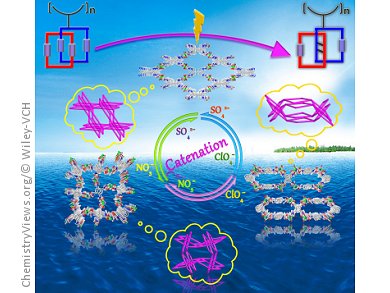Soft porous frameworks as the third-generation family provide an alternative platform and unique application features for inclusion and recognition of guest molecules by virtue of their versatile structure phase with variable pore sizes and functions. Jie Zhang and her co-workers, Fujian Institute of Research on the Structure of Matter, Chinese Academy of Science, Fuzhou, China, have developed a method to construct a series of soft nanoporous metal–organic framework (MOF) materials by polycatenation of an isoreticular 1D ribbon of rings, and systematically functionalize the pore metrics.
In a pre-synthetic process, the orientation of catenated ribbons can be fine-tuned by varying counter anions, thus allowing both the pore size and shape to be systematically adjusted. They can also interconvert into each other by means of anion exchange, leading to a transformation of the interpenetrating structures in different dimensional networks, which is unusual in porous frameworks. In addition, the porous framework can be post-synthetically modified by a photoinduced [2+2] cycloaddition reaction. This leads to surface modification and structural transformation from low to high dimensions.
Such a post-modification process reinforces the pore architecture through a covalent locking effect and has a great impact on the adsorption properties.
- Polycatenation-Driven Self-Assembly of Nanoporous Frameworks Based on a 1D Ribbon of Rings: Regular Structural Evolution, Interpenetration, Transformation, and Photochemical Modification,
J.-K. Sun, B. Tan, L.-X. Cai, R.-P. Chen, J. Zhang, J. Zhang,
Chem. Eur. J. 2014.
DOI: 10.1002/chem.201303700




